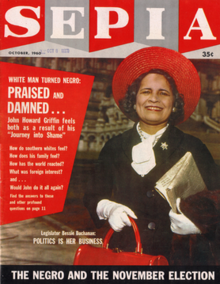Sepia (magazine)

October 1960 cover of Sepia featuring Bessie A. Buchanan
|
|
| Editorial director | Adelle Jackson |
|---|---|
| Categories | Photojournalistic magazine |
| Publisher | George Levitan |
| Total circulation (1983) |
160,000 |
| Year founded | 1947 |
| Final issue | 1983 |
| Company | Good Publishing Company |
| Country | United States |
| Based in | Fort Worth, Texas |
| Language | English |
| ISSN | 0037-2374 |
| OCLC number | 1765397 |
Sepia, a photojournalistic magazine styled like Look and sometimes compared to Ebony, featured articles based primarily on achievements of African Americans. It was part of the rise of postwar publications and businesses aimed at black audiences. The magazine was founded in 1946 as Negro Achievements by Horace J. Blackwell, an African-American clothing merchant of Fort Worth, Texas. He had already founded The World's Messenger in 1942, featuring romance-true confession type stories of working-class blacks. Blackwell died in 1949.
George Levitan, a Jewish-American man born in Michigan, who was a plumbing merchant in Fort Worth, bought the magazines and Good Publishing Company (aka Sepia Publishing) in 1950. He changed the magazine's name gradually; in 1954 he named it Sepia, and published it until his death in 1976. He changed the name of Messenger to Bronze Thrills and had success with that for some time as well, also publishing black-audience magazines Hep and Jive. After his death, Sepia was bought by Beatrice Pringle, who had been part of Blackwell's founding editorial team. She continued it until 1983, closing it despite respectable circulation. It was always overshadowed by Ebony, founded and published in Chicago.
In the postwar environment, when the South was still legally segregated, the publishing history of Sepia, based in Fort Worth, Texas reflects other changes. It was founded as Negro Achievements by Horace J. Blackwell, an African-American clothing merchant. His editorial team relied on director Adelle Martin Jackson, who had advanced from starting as a stenographer, and Beatrice Pringle. This was the beginning of the magazine's tradition of having women in "important editorial positions."
Blackwell had already started the romance-True Confessions-type magazine, The World's Messenger, in 1942. His innovation was to feature stories written in the dialect of Southern working-class African Americans, providing them with a familiar style.
After Blackwell's death, his magazines and Good Publishing Company were bought by George Levitan, a Jewish-American plumbing merchant born in Michigan. He also published other titles for the black market. After his death in 1976, Sepia was bought by Beatrice Pringle, returning it to black ownership but under a woman publisher. All three publishers were outside the majority white Anglo-Saxon males who occupied positions comparable positions with mainstream magazines. But they developed a magazine to appeal to the African-American market, which was receiving new attention in the postwar period, and had considerable success for decades, building distribution to a national audience. While Sepia did not equal the newsstand sales of Levitan's true confessions-type magazine The World's Messenger (renamed as Bronze Thrills), it was the most successful magazine to compete with Ebony for nearly four decades, building a base of national advertisers.
...
Wikipedia
